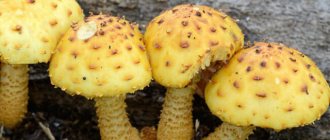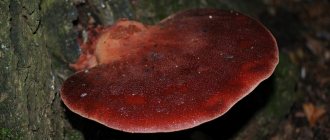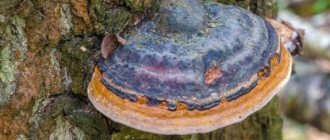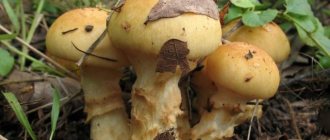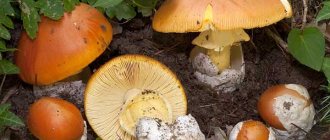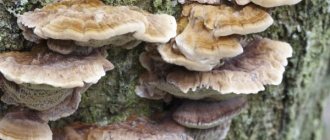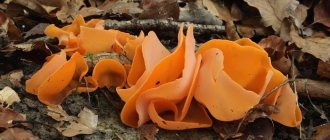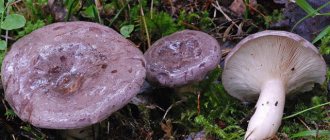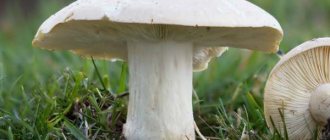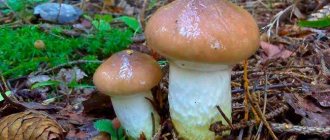The edible tinder fungus, also called albatrellus ovinus, or scutiger ovinus, has a round cap with a large diameter. It grows in groups where individual specimens can connect with each other, fused by the edges of the caps. Due to the resemblance of such clusters to a flock of sheep, the mushroom got its name. These islands can be quite large and are a good find for a mushroom picker.
Since the sheep mushroom is consumed raw, it can be used as a refreshment during forest walks.
Polypores are found in the forest from mid-summer until late autumn. In central Russia, this mushroom can only be found far from well-trodden paths. It grows in larger quantities in Siberia. To learn how to distinguish it from other species, it is recommended to find out what the sheep tinder fungus looks like in the photo.
Description of the sheep polypore
Sheep tinder, also called sheep albatrellus, is a mushroom with dense, brittle white flesh that turns yellow when dried or lightly pressed. Most often the smell is not very pleasant, soapy, but some claim that the smell can be flour or almond.
It is easy to recognize the sheep tinder fungus by its characteristic structure.
The easiest way to recognize fruiting bodies is by the structure of the cap and stem. Therefore, the photo and description of the sheep tinder fungus should be studied more carefully.
Description of the cap
Sheep tinder fungus is a medium-sized mushroom, the cap of which can reach 10 cm in diameter. It is most often round in shape, but the edges can be wavy or lobed, sharp and thin. In the photo of the sheep's tinder fungus, it is noticeable that the caps of mature fruiting bodies often crack, while on young ones they are smooth, silky to the touch and covered with smooth skin. The color of the mushroom varies from whitish to beige and cream.
The cap of the albatrellus sheep is wavy, with a thin sharp edge
The lower surface of the cap of the sheep tinder fungus is tubular, running strongly down the stem. The color of the tubes is also white, cream, greenish-yellow or lemon-yellow, and noticeably turns yellow when pressed. The pores of the tinder fungus are round or angular in shape.
Description of the leg
The sheep albatrellus mushroom rises on average 3-7 cm above the ground, the girth of the leg is up to 3 cm. The structure of the leg is dense and smooth, solid from the inside, the shape is straight or slightly curved, with a slight narrowing towards the base. A photo of a sheep's mushroom shows that the color of the stem is the same as the rest of the mushroom, white, cream, beige or grayish.
Albatrellus syringae
Syn: Scutiger syringae Parmasto, 1962 Xanthoporus syringae (Parmasto) Audet, 2010
Description by Andrey Yakimenko and Tatyana Svetlova.
Click on the marker to get additional information about the discovery of this species. If you know another place where this species grows, please determine its coordinates and send them to the site
Basic information Additional Section-3
On off. mushroom finds map
| The full scientific name of this species is Albatrellus syringae (Parmasto) Pouzar, 1966 |
This species belongs to the tinder fungi, despite the fact that it lives on the soil and has fruiting bodies with a cap and a stalk. The caps are yellow in color and usually have several darker areas; legs narrowed towards the base, with mycelial cords. The fruiting bodies very often grow together with the stems and edges of the caps in several copies. It grows near the trunks and stumps of lilacs and some other deciduous trees. Rare view. (Tatiana Svetlova)
Common names Common names FI: Keltakääpä (Finland) DE: Wiesen-Porling; Gezonter Porling (Germany) DK: Gul Fåreporesvamp (Denmark)
Fruiting body Sporecap Fruiting bodies are annual, consisting of a cap and a stalk, solitary or fused in 2-4 copies. Caps are 3–12 cm in diameter up to 1 cm thick, with a thinner, sharp wavy or lobed edge, round, kidney-shaped, funnel-shaped, sometimes convex in the center. The surface is bare or slightly pubescent, yellow-cream, ocher-yellow, clearly or unclearly zoned, with darker zones, often egg-yellow along the edges, brownish in old age.
Hymenophore Hymenophore Tubules running down the stalk, up to 3 mm long, thick-walled. The surface of the hymenophore is pale lemon, yellow-cream, later dirty yellow with a whitish coating. Pores are round, angular, sometimes with ciliated edges, 3-4(5) per 1 mm.
Micromorphology Micromorphology The hyphal system is monomitic. The hyphae of the tissue of the cap and stalk are densely woven, hyaline, branching, sinuous, thin-walled, with a varying diameter from 3 to 15 µm, in swellings up to 25 µm in diameter, with small buckles. The hyphae of the tubes are densely woven in parallel, often with granular contents, 2-5 µm in diameter. The basidia are club-shaped, with a buckle at the base, 15–25 x 5–7 µm, with 4 sterigmata 2–4 µm long. The spores are broadly ellipsoidal, flattened on one side, hyaline, with a large droplet, 3.5 – 5 x 2.5 – 3.5 µm.
Leg Stem The leg is densely fleshy, brittle, somewhat fibrous, often central, 1 – 7 cm long, 1 – 2 cm in diameter, tapering towards the base, with mycelial cords. The color is cream, ocher-yellow. Older fruiting bodies may have a hollow stem.
Flesh Cap tissue is fleshy, slightly fibrous, zonal, whitish or dark cream with a pleasant nutty flavor; When dry, it is hard and brittle.
Habitat Grows on the soil in parks, forests, near trunks or stumps of lilac, willow, linden, alder.
Distribution Areal The species is distributed in Europe, Asia, and North America. On the territory of Russia it is recorded in the European part (Moscow region), Western Siberia (Yamalo-Nenets Autonomous Okrug), Irkutsk region, and the Far East.
Calendar Calendar Grows from spring to late autumn.
Edibility Edibility Edible.
Notes Remarks The species is included in the Red Lists of the following European countries: Estonia (CR), Norway (LC). It is not listed in the Red Books of the constituent entities of the Russian Federation, as well as the Red Book of Russia. Note: the status in parentheses characterizes the degree of rarity of the described species in a given country.
Authors of the taxon: Parmasto - Parmasto, Erast (1928-), Estonian botanist and mycologist - described this species as Scutiger syringae; Pouzar – Pouzar, Zdenek (1932-), Czech mycologist.
Where and how does it grow
The sheep polypore in Russia can be found from mid-summer to the end of autumn, mainly in the Far East and Siberia, as well as in the Central region. It grows mainly in mixed and coniferous forests under spruce trees, and is also found on the edges and clearings, in clearings and on roadsides. For growth, the fungus often chooses moss cover and alkaline or neutral soils.
Sheep albatrellus can be found in single specimens, but more often the mushroom grows in small groups. In this case, the fruiting bodies are usually closely pressed to each other and even grow together with the legs and edges of the caps.
Important! Although the distribution range of sheep albatrellus is quite wide, the mushroom is classified as rare. In practice, it is very rare to find it in the forest.
Interesting facts about the mushroom
In Russia, dung beetles were unpopular for a long time, they were called “toadstool,” but, for example, in the Czech Republic, Finland and France, these mushrooms have long been highly valued and considered a delicacy. Gray and white dung beetles were used to make ink. Mature mushrooms were placed in dishes and the liquid obtained after autolysis was filtered and glue and clove oil were added to it as a flavoring agent.
Such ink was added to regular ones as a means of protecting documents of national importance and bills of exchange. After drying, the fungal spores form a unique pattern, which was examined under a microscope and manually fixed. Gray dung beetle causes poisoning in people who are intoxicated, but the mushroom remains harmless to non-drinkers
Due to these properties, the mushroom species is used as an anti-alcohol agent.
- Albatrellus ovine is included in the Red Books of the Moscow and Sverdlovsk regions.
- In medicine, the anesthetic drug cutigeral is used, the active substances of which were isolated from the fruiting bodies of albatrellus ovine.
- In nature, the sheep's albatrellus is a forest orderly, since the fungus decomposes organic compounds and thereby fertilizes the soil.
Doubles and their differences
The sheep tinder fungus has quite a lot of doubles - mushrooms that are similar in structure, but differ in color and taste. The tinder fungus has no toxic counterparts, but it should still not be confused with related species. Not all similar mushrooms can please with the same pleasant taste.
Merging tinder fungus
Related species can be confused primarily because of their structure. The merging polypore also has a rounded cap with wavy edges, and often grows in small groups of several fused fruiting bodies.
You can distinguish mushrooms by color - the merging polypore is much darker, its color is closer to reddish-brown. You can also eat a related species, so the mistake in this case does not pose a danger.
Yellow hedgehog
You can accidentally confuse sheep's albatrellus with yellow hedgehog - the fruiting bodies are similar in size and shape of the cap. It is also round, slightly wavy, and it often grows in groups of several specimens. Yellow brambleberries are edible, although some sources claim that the mature fruiting bodies are too bitter.
You can distinguish between the sheep's tinder fungus and the yellow hedgehog mushroom by color - the hedgehog mushroom is much brighter, it has a pronounced yellow tint. In addition, the structure of the hymenophore is different - on the underside of the cap of the hedgehog there are not tubes, but peculiar spines, as if hanging vertically down.
Blushing albatrellus
This related species also has a wide cap with a wavy edge; it sometimes reaches 10 cm in width. You can distinguish between sheep and blushing albatrellus by color - the blushing mushroom is characterized by light ocher, light brown or light brown shades. You can also recognize it by its slightly pinkish pubescent stem, which turns red when dried.
Attention! Blushing albatrellus is not poisonous, but is not eaten. The flesh of the mushroom is too bitter and therefore cannot decorate edible dishes.
Crested albatrellus
Inexperienced mushroom pickers who have not properly studied the photo of the sheep polypore may mistakenly mistake the related albatrellus crested for it. This mushroom is characterized by a wide cap with curved wavy edges; in general, the varieties are very similar in shape.
But at the same time, the comb polypore has a pronounced olive-brown or greenish-brown color. The mushroom should not be eaten; it is not poisonous, but it has an unpleasant taste and its flesh is too hard.
Similar species
The sheep's tinder fungus resembles other types of tinder fungus, as well as the yellow tinder fungus, and differs from them in color.
All of them are edible mushrooms:
- Yellow hedgehog.
Specific yellow skin on the cap.
- Albatrellus confluent.
Very similar, but can be distinguished by its darker brown cap.
- The tinder fungus is sulfur-yellow.
Differs in color close to orange. The pulp tastes unpleasant, bitter or sour.
1- Yellow hedgehog. 2- Albatrellus confluent. 3- The tinder fungus is sulfur-yellow.
- Albatrellus blushes.
From ocher to light brown color. Bitter taste.
- Albatrellus cristata.
A mushroom with a greenish tint to the skin.
1- Albatrellus blushes. 2- Albatrellus cristata.
Is sheep mushroom edible or not?
Experts do not rate the taste qualities of sheep albatrellus very highly; it only belongs to the 4th category of edibility. But, nevertheless, the sheep tinder fungus is completely suitable for consumption, although it is preferable to choose only young, fresh fruiting bodies for cooking.
Important! The description of the sheep mushroom suggests that in the Moscow region and in some other regions it is listed in the Red Book. This means that it cannot be collected - the species is on the verge of extinction.
Evaluation of mushroom by taste
With age, the sheep tinder fungus becomes tough and unsuitable for food. The slight bitterness, which gives young specimens a memorable note of taste, eventually turns into a distinct bitterness that makes harvesting old mushrooms impractical.
Even if you soak and cook cracked old polypores for a long time, they will remain quite hard. Therefore, for preparing dishes, they use young specimens with delicate light skin, which has not yet had time to harden and become covered with cracks.
Young mushrooms can even be eaten raw, which is actively used by experienced mushroom pickers. The age of the mushroom is determined by touch: it is softer. To select the most suitable specimens for subsequent preparation, sheep polypore can be tasted right during collection.
How to cook sheep tinder
Sheep tinder fungus is consumed in a variety of ways. It is used in cold appetizers and hot dishes, prepared for the winter and dried for medicinal purposes.
Preparing mushrooms
Before cooking sheep albatrellus, it must be processed. The preparation consists of cutting off the lower part of the stem of the mushroom, and then washing and boiling the fruiting body in salted water. Cooking should take 15-20 minutes.
During the boiling process, the light flesh of the tinder fungus acquires a greenish-yellow hue. This is completely normal and should not be a cause for concern.
Sheep tinder soup recipe
You can make a nutritious and tasty soup from the pulp of sheep albatrellus. The recipe looks like this:
- fresh tinder fungi in an amount of 1 kg are cleaned, the stems are cut off and the caps are cut into small pieces;
- the tinder fungi are boiled for 15 minutes, at the same time 4 onions, cut into half rings, are lightly fried in oil in a frying pan;
- when the onion acquires a light golden hue, add it to the pan with mushrooms, and also add 350 g of millet, buckwheat or any other cereal, a little herbs to taste and your favorite seasonings.
The soup is boiled until the cereal is completely cooked, after which it is removed from the stove and served.
How to make sheep tinder rolls
Mushroom rolls made from tinder fungi can become a decoration for your home table. It’s very easy to prepare them, all you need is:
- boil and then lightly fry 300-500 g of tinder fungus in vegetable oil;
- pass the fried tinder fungi through a meat grinder or cut into very small pieces with a knife;
- mix minced mushrooms with chopped onions, boiled eggs and pieces of cheese, the proportions are determined according to your own taste;
- If desired, add a little mayonnaise, and then carefully wrap in pita bread.
Mushroom rolls are distinguished not only by their pleasant taste, but also by their nutritional value, so they can act as an independent snack.
Use of albatrellus ovine in cooking
Sheep tinder fungus is an edible mushroom that belongs to the fourth category. It is not very popular among mushroom pickers for two reasons. Firstly, it is not very common and quite difficult to find. Secondly, it is advisable to eat only young mushrooms. A mature plant acquires excessive rigidity, which is not removed even after prolonged heat treatment. You can eat sheep mushroom in any form: boiled, fried, stewed.
How to dry a mushroom
These mushrooms are great for drying. You can dry them in different ways: in the sun, in the oven, in the oven or on a gas stove. Mushrooms are dried outdoors only in sunny, dry weather, otherwise they may spoil. Mushrooms must be fresh, healthy, and not damaged by worms. They need to be cleaned, wiped with a clean damp cloth and separated by size. Mushrooms should not be washed; they easily absorb water and dry poorly. It is best to use special devices for drying. You can make sieves, meshes, and gratings yourself. You can string mushrooms on a thread or special pins. Since mushrooms dry unevenly, you need to constantly monitor the process. An overdried mushroom loses its taste, while an underdried mushroom will quickly become moldy and spoil. The finished tinder fungus is dry, light, and close to fresh in taste and aroma. They should be stored in dry, ventilated areas, packed in sealed metal or glass jars. It is not recommended to keep dried mushrooms in fabric bags, as they easily absorb moisture and foreign odors.
How to pickle sheep's tinder fungus
Other ways to store sheep polypores are salting and pickling. Mushrooms are salted in glass, enamel or wooden containers. Peeled and washed mushrooms should be boiled in lightly salted water for about half an hour. Then drain the water and place the mushrooms in a colander. Next, put them in a pickling container and add salt at the rate of 50–60 grams per kilogram of mushrooms. You can add garlic, pepper, bay leaf. We put him under oppression. And within a week you can eat a delicious dish. These mushrooms should be stored in a cool place. Make sure that the brine completely covers the mushrooms.
Albatrellus soup
Albatrellus can be used to make a very tasty soup. To do this, you need to take a kilogram of fresh mushrooms, sort them, peel them, remove the stems, and wash them thoroughly. Fill the finely chopped mushrooms with water and cook for about 15–20 minutes. Saute four onions in vegetable oil. To the boiling mushrooms add 350 grams of any cereal, fried onions, herbs, seasonings to taste and bring to readiness.
Main courses and salads
Tinder fungi add special sophistication to main courses and salads. Try making mushroom rolls. To do this, fresh mushrooms need to be boiled and then fried until tender. Next, grind them into minced meat, adding onion, garlic, salt, and pepper. Add finely chopped boiled eggs and mayonnaise to the resulting minced meat. From the resulting mixture we form small sausages and wrap them in slices of ham. Place the rolls on a deep dish, decorate as desired and fill with meat jelly. The cooled dish is ready to eat.
Pickled mushrooms are also widely used in the kitchen. They can be used to make delicious salads. Here is the recipe for one of them. Chop a kilogram of salted or pickled mushrooms, add finely chopped green onions to them. Mix mushrooms with diced boiled potatoes (300 grams) and a jar of green peas. The dressing for this salad is mayonnaise; Add salt and pepper to taste.
Albatrellus sheep (sheep's tinder fungus, sheep's fungus)
Preparations from sheep tinder for the winter
Sheep tinder fungus can be stored for the winter, in which case it can be consumed even several months after collection. Basically, 2 methods of processing mushrooms for long-term storage are used.
Drying
Drying sheep tinder is very easy. To do this you need:
- clean fresh mushrooms from soil, adhering needles and other debris;
- wipe them with a towel or paper napkins;
- string on a thin thread and hang in a dry place with good ventilation.
When the pulp begins to crumble when rubbed between your fingers, the tinder fungus can be placed in a dry glass jar. When drying, it is important to monitor the humidity level in the room - in damp conditions, albatrellus will simply become moldy. Before drying, mushrooms should not be washed, otherwise they will only gain excess moisture.
Pickling
Among the recipes for preparing sheep mushroom, pickling is very popular. The recipe looks like this:
- mushrooms are cleaned and boiled in salted water for 30 minutes;
- then the tinder fungi are transferred to a glass jar and covered with salt at the rate of 50 g per 1 kg of fruiting bodies;
- after that, add a few bay leaves, 2-3 chopped garlic cloves, a few black peppercorns to the jar;
- The ingredients are mixed thoroughly and covered with pressure.
In just a few days, the marinade will completely cover the fruiting bodies in the jar, and after a week the tinder fungi can be served.
Albatrellus ovinus
Other names:
- Scutiger ovinus
Albatrellus ovinus, sheep's mushroom (Albatrellus ovinus) grows in dry pine and spruce forests. Belongs to the well-known mushroom family Polypores.
Description: The rounded mushroom cap reaches ten centimeters in diameter. In an old mushroom it cracks. The skin of the cap of a young mushroom is dry and silky to the touch. The lower surface of the mushroom cap is covered with a fairly dense layer of white tubes, which are easily separated from the pulp of the mushroom. The surface of the cap is dry, bare, initially smooth, silky in appearance, then slightly scaly, cracking in old age (especially during dry periods). The edge of the cap is thin, sharp, sometimes pubescent, from slightly wavy to lobed.
The tubular layer strongly descends onto the stalk, the color varies from white or cream to lemon yellow, greenish yellow, and turns yellow when pressed. The tubes are very short, 1–2 mm in length, the pores are angular or round, 2–5 per 1 mm.
The leg is short, 3–7 cm long, thick (1–3 cm thick), strong, smooth, solid, central or eccentric, narrowed towards the base, sometimes slightly bent, from white (cream) to gray or light brown.
Spore powder is white. The spores are almost round or ovoid, transparent, smooth, amyloid, often with large drops of fat inside, 4 – 5 x 3 – 4 µm.
The pulp is dense, cheese-like, brittle, white, yellow or yellowish-lemon when dry, and often turns yellowish when pressed. The taste is pleasant, mild or slightly bitter (especially in old mushrooms). The smell is rather unpleasant, soapy, but according to some literary data it can be either inexpressive or pleasant, almond or slightly mealy. A drop of FeSO4 colors the pulp gray, KOH colors the pulp dirty golden yellow.
Distribution: Albatrellus sheep is found infrequently from July to October on the soil under spruce trees in dry coniferous and mixed forests in clearings, clearings, edges, near roads, as well as in the mountains. Prefers neutral and alkaline soils, often growing in moss. Forms clusters and groups with fruiting bodies closely pressed to each other, sometimes fused with legs and edges of caps. Single specimens are less common. The species is widespread in the northern temperate zone: recorded in Europe, Asia, North America, and also found in Australia. On the territory of Russia: in the European part, Siberia and the Far East. Moss cover is considered a favorite place for growth. The tinder fungus is a fairly large mushroom. It grows singly or in groups, sometimes fused with legs.
Similarities: Albatrellus sheep in its appearance is similar to the confluent polypore, which has a browner color. Yellow hedgehog (Hydnum repandum) is distinguished by a hymenophore, consisting of thick light cream spines, slightly descending onto the stalk. Confluent albatrellus (Albatrellus confluens) is colored orange or yellowish-brown tones, with a bitter or sour taste. It has fused, usually non-cracking caps, grows under various coniferous trees. Albatrellus subrubescens is orange, light ocher or light brown, sometimes with a purple tint. The tubular layer is light orange. It grows under pines and spruces, has a bitter taste. Albatrellus cristatus has a brown-green or olive cap, grows in deciduous forests, most often in beech groves. Lilac albatrellus (Albatrellus syringae) is found in mixed forests, colored golden yellow or yellowish-brown tones. The hymenophore is not pedunculated, the flesh is light yellow.
Rating: Albatrellus ovine is a little-known edible mushroom of the fourth category. The mushroom is suitable for consumption only in its unripe form. Young caps of this mushroom are consumed fried and boiled, as well as stewed. Before use, the mushroom must be boiled, first removing the lower part of its stem. During the boiling process, the mushroom pulp acquires a yellowish-green color. The mushroom is considered especially tasty when fried raw without prior boiling or heat treatment. Albatrellus can be pickled with spices for long-term storage.
The species is listed in the Red Book of the Moscow Region (category 3, rare species).
Used in medicine: scutigeral, isolated from the fruiting bodies of the polypore, has an affinity for dopamine D1 receptors in the brain and can act as an oral pain reliever.
Medicinal properties
Sheep polypores contain all the essential vitamins and minerals, as well as amino acids, organic acids, fiber, antibiotic and immunomodulatory substances. Therefore, with regular use of albatrellus:
- works as a natural anti-inflammatory and prevents the development of infections;
- reduces pain in chronic and acute diseases;
- increases the body's immunity due to the significant content of vitamin C and folic acid;
- has a beneficial effect on the skeletal system and strengthens blood vessels;
- helps normalize digestion.
Eating fruiting bodies is useful if you are prone to anemia; sheep polypore contains a lot of proteins, so it helps to quickly gain muscle mass and improves blood composition.
The use of sheep mushroom in folk medicine
Sheep polypore can often be found in home health recipes. Based on it, decoctions and water infusions, alcohol tinctures and dry powders are prepared.
The substance grifolin in the mushroom is of particular value; it suppresses the growth of malignant cells and helps prevent cancer.
Sheep polypore is also used to relieve inflammatory processes during colds, infections and joint ailments - neogrifolin in its composition helps fight negative processes.
Polypore contains the substance scutigeral, which is considered an effective painkiller and can be used to relieve discomfort from a wide variety of ailments.
Advice! You can use tinder fungus for treatment as part of medicinal tinctures and decoctions, but simply eating the fungus also brings benefits for diseases.
The main thing is that sheep albatrellus is present on the table on a regular basis.
Eating sheep tinder is good for your health
Useful properties and applications
Sheep polypore has a lot of healing properties. Quite often it is collected for medicinal purposes, as it contains an anti-inflammatory element called grifolin, as well as neogrifolin, which is a powerful antioxidant. Sheep polypore also contains a substance called cutigeral, which has a similar property to dopamine D1, which has an analgesic effect. Only whole mushrooms are collected for use in medicines. They are relatively small in size and have a solid cap and stem. These mushrooms are then added to alcohol tinctures, and dried and ground to a powder.
In cooking, this mushroom has also become widespread. However, already mature mushrooms are not very pleasant to the taste, since over time they become extremely tough. It is noteworthy that sheep polypore can be consumed even raw. It can also be soaked and boiled. But old tinder fungi are not exposed to high temperatures, so they will not become softer after cooking. This mushroom acquires a special flavor after frying it raw without additional processing.
Restrictions and contraindications
Despite its numerous beneficial properties, sheep polypore can be harmful to health. It is not recommended to use it:
- during exacerbations of chronic stomach diseases, tinder fungus is slowly digested and can create unnecessary stress on the digestive tract;
- with a tendency to constipation;
- for serious liver diseases;
- during pregnancy and lactation.
Also, it is better not to offer fruiting bodies to children under 10 years of age, as their intestines may not be able to cope with the absorption of tinder fungus.
Symptoms of poisoning
If chanterelle poisoning occurs, the condition will deteriorate within 30 minutes to 3 hours after eating forest products. Often, symptoms and signs of poisoning appear only the next day. The period depends on the number of talkers eaten and the time devoted to their processing. A person’s age and the presence of chronic diseases are of great importance.
If the chanterelles turn out to be poisonous, the symptoms of poisoning will be as follows:
- pain in the epigastric region;
- weakness;
- severe nausea;
- repeated vomiting;
- diarrhea (less commonly constipation).
If bacteria enter a thermally processed product, the symptoms will be complemented by an increase in body temperature. The intensity of the symptoms depends both on the toxicity of the fungi and on the type of microbe that caused the disorder.
If botulism occurs, which can masquerade as chanterelle poisoning, the following will appear:
- sudden visual impairment (double vision, fog, blurriness);
- muscle weakness;
- dry mouth.
Eating poisonous mushrooms may be accompanied by increased salivation, sudden jumps in blood pressure, and constriction or dilation of the pupils.
In all cases, seek immediate medical attention.
Despite the benefits and composition, which includes a large number of substances necessary for the human body, real chanterelles and their doubles (false) are considered mushrooms that are difficult to digest. This is explained by the presence of chitin in the pulp of the former, and toxic substances in the latter. Eating even a small amount of this product can cause illness in people suffering from pathologies of the gastrointestinal tract and enzyme deficiency. In severe cases, undigested mushrooms can clog the intestines, which will require urgent medical attention.
First aid for chanterelle poisoning
Even if a person is not afraid of being poisoned by mushrooms and believes that the product was of high quality, if negative symptoms occur after eating chanterelles, it is necessary to call an ambulance.
Before her arrival, the following measures must be taken:
- Perform gastric lavage by drinking 4-5 glasses of warm boiled water and pressing on the root of the tongue with the handle of a spoon to induce vomiting. The procedure is repeated until the vomit becomes transparent.
- Cleanse the intestines with an enema with warm boiled water.
- Drink 10-15 tablets of Activated Carbon, 1 sachet of Enterosorb or 1 tbsp. l. Enterosgel. The latter must be dissolved in half a glass of warm water.
- Take 20 g of a salt-based laxative (Magnesia sulfate, Barbara's salt).
- Drink large quantities of clean drinking water.
In most cases, orange talker poisoning is not severe, and stabilization of the condition can be achieved fairly quickly.
How to grow sheep mushroom at home
The rare red-listed albatrellus is not often found in the forest and is sometimes prohibited for collection. However, it can be grown in the country at home. The algorithm looks like this:
- mycelium, purchased in a specialized store or online, is mixed with a nutrient substrate of wood shavings, sawdust and small twigs;
- the substrate is placed in clean plastic bags with cuts for air access, moistened with water and left in a warm room with a temperature of at least 20 ° C;
- The lighting in the room should be natural; mushrooms do not like bright sunlight, but they also do not grow in complete darkness.
From time to time, the substrate is moistened, not allowing it to dry out. Within a month, the first fruiting bodies can grow.
You can grow sheep mushroom in your dacha
Places of distribution and time of collection
Valui are found in abundance in deciduous or mixed forests of temperate climates - singly or in groups. But most often, the productive species settles in large clearings, forming numerous colonies under birch, oak, and aspen trees. The mycelium also grows, forming mycorrhiza under coniferous trees, usually under pine. Favorite places of growth are wet lowlands, shady, damp corners of the forest.
Another person will not bend over, but will pry the edge of the cap with his foot, pick it off, examine the plates and, making sure that it is not a porcini mushroom in front of him, but a low-value bitter valuu, will pass by. But a real connoisseur will collect a bucket of valuev, pickle it and enjoy the appetizing snack.
Comparison of real and false chanterelles
Every lover of collecting forest gifts should know what a false chanterelle looks like. To determine the differences, it is necessary to familiarize yourself in detail with each type. Varieties of chanterelles such as tubular, gray, white and others do not have doubles, but the common cockerel can be confused with the orange talker.
The fox is real
False fox
Despite the fact that edible and false specimens are very similar, an experienced mushroom picker can easily distinguish them from each other. This is where simple advice from an experienced forest lover comes in handy. Even though these are delicious mushrooms, you should remember that they have doppelgängers. I’ll tell you how I identify chanterelles: you can focus on the color of their caps and the shape of their legs. Thus, everyone’s favorite cockerels are distinguished by their muted reddish color.
The surface of their cap is matte, always smooth, the skin is almost inseparable from the pulp - thick, juicy, matching the shade of the stem. Sometimes the flesh of the mushroom can be very light, almost white. When broken and pressed, it turns slightly red.
The edges of the cap when young are smooth and neatly rounded. As they grow, they curve beautifully, become wavy at the edges, and the fruiting body takes on a slightly funnel-shaped shape with a recessed center.
The real chanterelle is capable of growing to a large size. Often there are specimens with a cap diameter of about 10-12 cm.
Chanterelle mushrooms have a thick and strong stem. It expands at the top and smoothly passes into the cap. The color of the fruiting body does not change throughout its entire length and is uniform. The thickness of the leg is from 10 to 30 mm, the length is up to 7 cm. It is slightly lighter than the cap.
Cockerels do not have plates; the hymenophore consists of frequent, highly branched folds that descend onto the stalk, forming one whole with it.
The color of the false chanterelle's caps is brighter than that of real ones. So, when collecting gifts from the forest, a mushroom picker should be alerted by the yellow or orange, slightly velvety surface of the specimen encountered. The diameter of the cap of the cocoshka does not exceed 6 cm, the plates descend onto the stem. They are frequent, thin, bright. The pulp is white or yellow, with a pungent mushroom odor (if the aroma is sweetish, this also indicates that the specimen belongs to the Hygrophoropsis genus).
https://youtube.com/watch?v=Vj1KBldMpFw%3F
The pronounced difference between these mushrooms is that they have a rather thin (up to 10 mm) and long (up to 5 cm) stalk. It is smooth, but can rarely be curved. The inside is fibrous, with pulp resembling cotton wool. The color of the flesh of the stem does not match the shade of the cap; at the base it is darker (almost black).
Key differences
So, you need to remember the difference between the representatives of the two types of eukaryotes. They are the following:
- False chanterelles have a brighter color. Cockerels have a calm reddish tone.
- If the mushroom has a sour taste, and its stem is thick and smoothly turns into a cap, then it is an ordinary chanterelle. This mushroom has a slightly curved stem shape. Kokoshki have a thin and hollow stem.
- The chanterelle mushroom grows in large colonies, while the coco mushroom grows almost always in single specimens. It can be found on fallen and rotting tree trunks.
- All kinds of worms and larvae love to eat false chanterelles, while cockerels are extremely rarely spoiled by insects. The only worm that can be found when cutting the fruiting body of a betta is the wireworm. This fact is explained by the presence of a large amount of chitinmannose in the fruiting bodies of common chanterelles.
- Another difference is that false eukaryotes have an easily removable skin. When it is removed, the rough surface of the cap is exposed. It is almost impossible to remove the skin of cockerels.
- In orange talkers, the color of the plates is brighter than the tone of the cap, while in cockerels it is uniform and the same over the entire surface.
These are the main characteristics that show how one species differs from another.
Precautions for collection
Many people note that the bitter substances of tolopilus transfer to their hands. Therefore, it is better to assemble and clean it with high-quality gloves. You should not place them with other already collected mushrooms of a different family; the bitter taste is easily absorbed by them. Collecting in heavily contaminated soils (garbage, chemicals) is not recommended; Tylopilus fellows has the ability to absorb toxins, purifying the nature around. Consumption of such a mushroom is fraught with poisoning. It also accumulates radioactive isotopes, which, if ingested in large quantities, can even lead to death.
False doubles
Gorchak, in its color, structure and variability, is very similar to other representatives of tubular mushrooms - porcini mushroom, boletus, honey fungus, milk mushroom, champignon, goat, row, Polish and poisonous satanic. The differences can be seen in the photo.
In order not to confuse it with dangerous or beneficial twin mushrooms, you need to know a few simple rules and features. The main thing: boletus mushrooms, porcini mushrooms, and honey mushrooms have scales on their stems, while the gall mushroom has a mesh. The satanic one has a bright small leg (3-4 cm in diameter) of pink color, while the bitter tolopilus has a pale one. In the first, the hymenophore tubes turn blue when squeezed, while in the gall tube they are simply white.
How to distinguish from porcini mushroom?
White mushroom
The main difference from boletus: Tylopilus fellows has a strong mushroom smell and a very bitter taste. But it is undesirable to try, so you can determine it in another way. The first mushroom has a characteristic feature - often when cut, the body begins to darken, acquiring a pink tint. And it also has small scales on its stem, and the gallbladder has a small mesh.
At a young age, the cap of the bitterling has the peculiarity of bending, like that of the white one. But if you wet it, mucus begins to form on it, but the boletus does not have it. The color of the cap also has its own characteristics: in the gall cap, it barely differs from the general shade of the entire body, often has a little yellowness, and in the white cap, the legs are 90% darker.
Differences between bitterling and boletus
boletus
It is quite easy to distinguish the gallbladder from the boletus - it rarely appears in areas of deciduous plants, moreover, it chooses dark and damp places. However, sometimes amazing things happen in nature; spores can be transported to any place in various ways (even by the collector himself), so the appearance of bitterling is not excluded among deciduous trees.
The main difference can be noticed already on the leg: while the boletus has its own personal “credit card” in the form of a “birch” pattern, then the gallbladder has just a small pale mesh
You should also pay attention to the thickening of the stem: in the obabka it is straight, smooth and has a gray tint, while in the bitterling it is cone-shaped (with thickening towards the root). The first one has a smooth hat, while the second one has a velvety surface.

